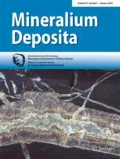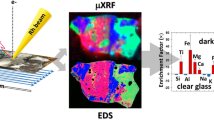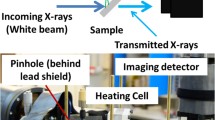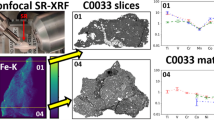Abstract
The Maia large solid-angle detector array and imaging system is capable of collecting high-resolution images of up to ∼100 M pixels in size with dwell times of less than 0.2 ms per pixel and thus it is possible to document variation in textures associated with trace element chemistry by collecting quantified elemental maps of geological samples on the scale of entire thin sections in a short time frame (6–8 hr). The analysis is nondestructive and allows variation to be recognised on a centimetre scale while also recognising zonations at the micron scale.
Studies of ore systems require microanalysis of samples to collect information on mineral chemistry in order to understand physiochemical conditions during ore genesis and alteration. Such studies contribute to the debate on whether precious metals are remobilised or introduced in multiple hydrothermal events. In this study we demonstrate the microanalytical capabilities of the Maia large solid-angle detector array and imaging system on the X-ray fluorescence microscopy beamline at the Australian Synchrotron to provide data for these studies. We present a series of case studies from orogenic gold deposits that illustrate the power of the Maia detector for constraining chemical zonations in sulphides and associated alteration minerals, which can be used to decipher ore-forming processes associated with gold deposition. A series of large-area (<7 cm2) elemental maps were collected with 2 to 4 μm pixel size using the Maia detector array. The data was processed using the GeoPIXE™ software package which allows variation in trace, minor and major element chemistry to be visualised in element maps. These maps are used to target further investigation with bulk spectra extracted and fitted for specific mineral grains and transects drawn through regions of interest. Analysis using the Maia detector offers a complementary method to map element distribution in geological samples that is both relatively fast and has a low detection limit for many elements of interest.





Similar content being viewed by others
References
Allibone AH, McCuaig TC, Harris D, Etheridge M, Munroe S, Byrne D, Amanor J, Gyapong W (2002) Structural controls on gold mineralisation at the Ashanti Gold Deposit, Obuasi, Ghana. SEG Spec Publ 9:29
Cline JS (2001) Timing of gold and arsenic sulfide mineral deposition at the Getchell carlin-type gold deposit, north-central Nevada. Econ Geol 96:75–89
Cook NJ, Ciobanu CL, Danyushevsky LV, Gilbert S (2011) Minor and trace elements in bornite and associated Cu-(Fe)-sulfides: a LA-ICP-MS study. Geochim Cosmochim Ac 75:6473–6496
Cook NJ, Ciobanu CL, Pring A, Skinner W, Shimizu M, Danyushevsky L, Saini-Eidukat B, Melcher F (2009) Trace and minor elements in sphalerite: a LA-ICPMS study. Geochim Cosmochim Ac 73:4761–4791
Dare SAS, Barnes S-J, Pritchard HM, Fisher PC (2014) Mineralogy and geochemistry of Cu-rich ores from the McCreedy East Ni-Cu-PGE Deposit (Sudbury, Canada): implications for the behavior of platinum group and chalcophile elements at the end of crystallisation of a sulfide liquid. Econ Geol 109:343–366
Diehl SF, Goldhaber MB, Koenig AE, Lowers HA, Ruppert LF (2012) Distribution of arsenic, selenium, and other trace elements in high pyrite Appalachian coals: evidence for multiple episodes of pyrite formation. Int J Coal Geol 94:238–249
Dyl KA, Cleverley JS, Bland PA, Ryan CG, Fisher LA, Hough RM (2014) Quantified, whole section trace element mapping of carbonaceous chondrites by Synchrotron X-ray fluorescence microscopy: 1. Oxidised and reduced CV meteorites. Geochim Cosmochim Ac 134:100–119
Fisher LA, Ryan CG (2014) GeoPIXE element maps of sample GQ1943_3. CSIRO. Data Collect. doi:10.4225/08/543DFA47E9878
Gregory MJ, Lang JR, Gilbert S, Olson Hoal K (2013) Geometallurgy of the pebble porphyry copper-gold-molybdenum deposit, Alaska: implications for gold distribution and paragenesis. Econ Geol 108:463–482
Groves DI (1993) The crustal continuum model for late-Archaean lode-gold deposits of the Yilgarn Block, Western Australia. Miner Deposita 28:366–374
Harlov DE, Wirth R, Förster H-J (2005) An experimental study of dissolution–reprecipitation in fluorapatite: fluid infiltration and the formation of monazite. Contrib Mineral Petr 150:268–286
Kirkham R, Dunn PA, Kucziewski A, Siddons DP, Dodanwela R, Moorhead G, Ryan CG, De Geronimo G, Beuttenmuller R, Pinelli D, Pfeffer M, Davey P, Jensen M, Paterson D, de Jonge MD, Kusel M, McKinlay J (2010) The Maia spectroscopy detector system: engineering for integrated pulse capture, low-latency scanning and real-time processing. AIP Conf Proc 1234:240–243
Kusiak M, Whitehouse MJ, Wilde SA, Nemchin AA, Clark C (2013) Mobilisation of radiogenic Pb in zircon revealed by ion imaging: implications for early Earth geochronology. Geology 41:291–294
Large RR, Danyushevsky L, Hollit C, Maslennikov V, Meffre S, Gilbert S, Bull S, Scott R, Emsbo P, Thomas H, Singh B, Foster J (2009) Gold and trace element zonation in pyrite using a laser imaging technique: implications for the timing of gold in orogenic and carlin-style sediment-hosted deposits. Econ Geol 104:635–668
Large RR, Meffre S, Burnett R, Guy B, Bull S, Gilbert S, Goemann K, Danyushevsky L (2013) Evidence for an intrabasinal source and multiple concentration processes in the formation of the carbon leader reef, Witwatersrand Supergroup, South Africa. Econ Geol 108:1215–1241
Lintern M, Anand A, Ryan C, Paterson D (2013) Natural gold particles in Eucalyptus leaves and their relevance to exploration for buried gold deposits. Nat Commun 4:2614. doi:10.1038/ncomms3614
MacKenzie D, Craw D, Finnigan C (2014) Lithologically controlled invisible gold, Yukon, Canada. Mineral Deposita. doi:10.1007/s00126-014-0532-5
Morey AA, Tomkins AG, Bierlein FP, Weinberg RF, Davidson GJ (2008) Bimodal distribution of gold in pyrite and arsenopyrite: Examples from the Archean Boorara and Bardoc shear systems, Yilgarn Craton, Western Australia. Econ Geol 103:599–614
Oberthür T, Weiser T, Amanor JA, Chryssoulis SL (1997) Mineralogical siting and distribution of gold in quartz veins and sulfide ores of the Ashanti mine and other deposits in the Ashanti belt of Ghana: genetic implications. Mineral Deposita 32:2–15
Paterson D, de Jonge MD, Howard DL, Lewis W, McKinlay J, Starritt A, Kusel M, Ryan CG, Kirkham R, Moorhead G, Siddons DP (2011) The X-ray flurorescence microscopy beamline at the Australian Synchroton. AIP Conf Proc 1365:219–222
Phillips GN, Powell R (2010) Formation of gold deposits: a metamorphic devolatilization model. J Metamorph Geol 28:689–718
Putnis A (2009) Mineral replacement reactions. Rev Mineral Geochem 70:87–124
Reich M, Deditius A, Chryssoulis S, Li J-W, Ma C-Q, Parada MA, Barra F, Mittermayr F (2013) Pyrite as a record of hydrothermal fluid evolution in a porphyry copper system: a SIMS/EMPA trace element study. Geochim Cosmochim Ac 104:42–62
Ryan CG (2000) Quantitative trace element imaging using PIXE and the nuclear microprobe. Int J Imag Syst Tech 11:219–230
Ryan CG, Kirkham R, Hough R, Moorhead G, Siddons D, de Jonge M, Paterson D, De Geronimo G, Howard D, Cleverley J (2010a) Elemental X-ray imaging using the Maia detector array: the benefits and challenges of large solid-angle. Nucl Instrum Method A 619:37–43
Ryan CG, Siddons DP, Kirkham R, Dunn PA, Kuczewski A, Moorhead G, De Geronimo G, Paterson DJ, de Jonge MD, Hough RM, Lintern MJ, Hoard DL, Kappen P, Cleverley J (2010b) The new Maia detector system: methods for high definition trace element imaging of natural material. In: Denecke MA, Walker CT (eds). X-Ray Optics and Microanalysis. AIP Conf Proc 1221:9–17
Ryan CG, Siddons DP, Kirkham R, Li ZY, de Jonge MD, Paterson DJ, Cleverley JS, Kuczewski A, Dunn PA, Jensen M, De Geronimo G, Howard DL, Godel B, Dyl KA, Fisher LA, Hough RH, Barnes SJ, Bland PAM, Moorhead G, James SA, Spiers KM, Falkenberg G, Boesenberg U, Wellenreuther G (2013) The Maia detector array and x-ray fluorescence imaging system: locating rare precious metal phases in complex samples. Proc SPIE 8851:88510Q. doi:10.1117/12.2027195
Ryan CG, Siddons DP, Kirkham R, Li ZY, de Jonge MD, Paterson DJ, Kuczewski A, Howard DL, Dunn PA, Falkenberg G, Boesenberg U, De Geronimo G, Fisher LA, Halfpenny A, Lintern MJ, Lombi E, Dyl KA, Jensen M, Moorhead GF, Cleverley JS, Hough RM, Godel B, Barnes SJ, James SA, Spiers KM, Alfeld M, Wellenreuther G, Vukmanovic Z, Borg S (2014) Maia X-ray fluorescence imaging: capturing detail in complex natural samples. X-Ray Optics and Microanalysis. J Phys Conf Ser 499:012002
Sung YH, Brugger J, Ciobanu CL, Pring A, Skinner W, Nugus M (2009) Invisible gold in arsenian pyrite and arsenopyrite from a multistage Archaean gold deposit: Sunrise Dam, Eastern Goldfields Province, Western Australia. Mineral Deposita 44:765–791
Tomkins AG (2013) On the source of orogenic gold. Geology 41:1255–1256
Vukmanovic Z, Reddy SM, Godel B, Barnes SJ, Fiorentini ML, Barnes SJ, Kilburn MR (2014) Relationship between microstructures and grain-scale trace element distribution in komatiite-hosted magmatic sulfide ores. Lithos 184–187:42–61
Yao Y, Robb LJ (2000) Gold mineralization in Palaeoproterozoic granitoids at Obuasi, Ashanti region, Ghana: ore geology, geochemistry and fluid characteristics. S Afr J Geol 103:255–278
Yardley BWD, Cleverley JS (2013) The role of metamorphic fluids in the formation of ore deposits. In: Jenkin et al. (eds) Ore deposits in an evolving Earth. Geol Soc London Spec Publ 393. doi:10.1144/SP393.5
Acknowledgments
This research was undertaken on the X-ray fluorescence microscopy beamline at the Australian Synchrotron, Victoria, Australia. The data presented in this paper were collected as part of run 6666 (Obuasi), 6189 and 4898 (Sunrise Dam) at XFM. Martin de Jonge (XFM beamline scientist) developed scan software and scripts that supported data collection. Micklethwaite and Fougerouse wish to gratefully acknowledge the support of the WAXI stage-2 AMIRA project (P934A) and an ARC linkage grant LP110100667. The Obuasi data forms part of Fougerouse’s PhD work which is supported by AngloGold Ashanti. The authors thank Steve Barnes and Belinda Godel for their constructive comments on a draft of this manuscript. We thank Rolf Romer and an anonymous reviewer for their constructive reviews of this manuscript. This research is supported by the Science and Industry Endowment Fund.
Author information
Authors and Affiliations
Corresponding author
Additional information
Editorial handling: R.L. Romer and G. Beaudoin
Rights and permissions
About this article
Cite this article
Fisher, L.A., Fougerouse, D., Cleverley, J.S. et al. Quantified, multi-scale X-ray fluorescence element mapping using the Maia detector array: application to mineral deposit studies. Miner Deposita 50, 665–674 (2015). https://doi.org/10.1007/s00126-014-0562-z
Received:
Accepted:
Published:
Issue Date:
DOI: https://doi.org/10.1007/s00126-014-0562-z




